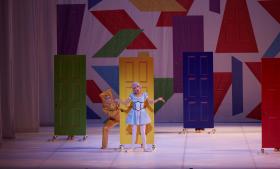As a male dancer, it has always been disheartening for me to hear people say that ballet is not for boys. While there may be stereotypes and misconceptions surrounding ballet being predominantly for girls, it is important to recognise that ballet is for anyone who has a passion and dedication for it, regardless of gender.
In fact, contrary to current perceptions, historically ballet was performed predominantly by male dancers, and female dancers were the minority, so the idea that it’s largely for females is far from the truth!
One of the common barriers for many boys interested in participating in ballet is the potential for ridicule or negative reactions from fathers and male relatives. This can create a challenging environment for boys who wish to pursue ballet.
By going against these traditional gender norms and stereotypes, we can create a more accepting and supportive environment for boys who are interested in ballet. It is essential to foster open-mindedness and educate individuals about the benefits and artistic value of ballet to help break down these barriers. By highlighting successful male ballet dancers and their achievements, we can inspire and encourage more boys to pursue their passion for ballet, regardless of societal expectations.
In recent years, there has been a growing awareness of equality and equal opportunity, which has led to a shift in perception and a greater acceptance of male dancers in ballet. Many male dancers have excelled in the field and have contributed significantly to the art form. It is encouraging to see the evolving mindset and the recognition of ballet as a sport and art form that can be pursued by individuals of all genders.
While it is true that the number of roles for boys may be fewer compared to roles for girls, this also depends on various factors, such as the repertoire being performed, the specific ballet company and the choreographic choices made by directors. It is necessary to note that these roles hold significance and can be highly sought after. Male dancers often perform roles that require strength, athleticism and partnering skills, which can be distinct from the roles typically performed by female dancers.
Furthermore, ballet companies and choreographers are continuing to advocate for equal opportunities by creating new works that showcase the talents of male dancers and provide them with more opportunities to shine. This includes contemporary ballet pieces that challenge traditional gender roles and explore diverse narratives, enabling male ballet dancers to fully express their artistic abilities on stage.
Read: Exit interview: Li Cunxin, Queensland Ballet
While traditionally there has been a higher representation of girls in ballet classes compared to boys, the number of males studying and participating in ballet has been steadily growing. At Tanya Pearson Academy, it is encouraging to see the consistent increase in the number of young male students, which aligns with the broader trend of more boys embracing ballet. This indicates a positive shift in perceptions and a recognition of ballet as a discipline that can be pursued by individuals of any gender.
We have also seen that the increased mainstream awareness of the benefits of ballet has led to a positive impact on its perception and popularity. Celebrity association, such as Prince George taking ballet classes, can serve as a testimonial and help break down stereotypes. When influential figures engage in ballet, it can inspire others and challenge the notion that ballet is exclusively for girls. Additionally, the incorporation of ballet into the training routines of professional athletes, such as professional boxer Harry Garside, highlights the physical and mental benefits that ballet can provide, regardless of gender. These examples contribute to a broader understanding of ballet as a discipline that can be embraced by individuals of all backgrounds and interests.
How ballet can improve athleticism
The integration of ballet into professional athletes’ training routines has gained recognition for the unique set of skills and advantages it offers. Ballet training enhances body awareness, strength, flexibility, mental focus and injury prevention, which can greatly benefit athletes in their respective sports. This recognition of ballet as a demanding and challenging activity highlights its physical demands and the dedication required to excel.
As ballet gains recognition for its athletic aspects, it creates a more inclusive environment where boys feel accepted to pursue their passion for the arts through this form of dance. This shift in perception allows boys to explore ballet as a means of artistic expression while also benefiting from the physical and mental advantages it provides.
As a former professional ballet dancer and now director of the Tanya Pearson Academy in Sydney, it is my mission to support the growth of boys in ballet and provide them with a safe and inclusive environment to pursue their passion.
We have incorporated specific part-time and full-time ballet programs for boys to nurture their skills and foster a sense of community among like-minded individuals. By offering a diverse range of classes, including classical ballet, contemporary dance, and pas de deux, along with boys-only workshops with male industry experts focusing on specific techniques, we are providing a comprehensive training experience that inspires and encourages boys on their ballet journey. This approach not only helps to break down gender stereotypes, but also contributes to the overall growth and positive change within the dance industry.
Read: Putting the science behind performers’ well-being
The new state-of-the-art facilities that the ballet academy has moved into are designed to provide an optimal learning environment for ballet athletes. Modelled after the renowned School of American Ballet in New York, these facilities offer a range of amenities that go beyond what is typically found in sports complexes. With seven dance studios, educational and exercise spaces, as well as a dedicated rehabilitation and physiotherapy room, the academy aims to create an ideal setting for dancers to develop their skills and pursue their aspirations, especially those aspiring to become professionals in the field. These well-equipped facilities can support the physical training, educational needs, and injury prevention and recovery of ballet athletes, ensuring they have the resources necessary to thrive in their pursuit of excellence.
We have recognised the importance of creating a professional and holistic training environment to support both male and female dancers equally. Providing a comprehensive and well-equipped Academy space that offers everything an athlete would need demonstrates a commitment to treating ballet as a serious sport and art form.
By offering equal opportunities and training resources to all students, we are contributing to the advancement and recognition of ballet as a discipline that requires athleticism and dedication. This inclusive approach helps create an environment where each student can train and develop their skills to their fullest potential, further promoting the idea that ballet is an activity that can be pursued by anyone, regardless of their gender.





